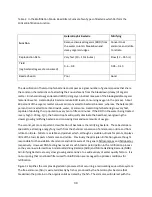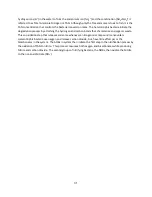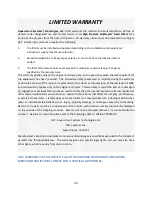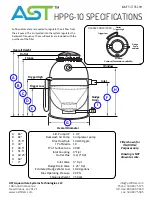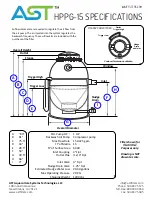
19
1.
The trigger is clogged. This condition occurs most often when a unit is just set up or
subject to heavy organic loading. Basically a clump of beads has jammed in the
trigger preventing air release.
a.
Try tapping the trigger on the inlet end (the low end) with a rubber mallet.
This will normally vibrate the clump free.
b.
Try tapping the trigger on the discharge end (the high end) with a rubber
mallet, the clog may be at this end.
c.
Try draining the filter about half way while the chamber is still filled with air.
This will increase the pressure differential and allow the clump of beads to be
pushed out.
d.
Remove the trigger and inspect for obstruction.
2.
The charge chamber is leaking (the filter has be recently transported):. Turn off the
air supply to the charge chamber. If the bubbles continue, then you may have a leak.
Pull the filtration head and screen. Remove the beads. Fill the unit with water until
the trigger out let is covered by about 12 inches of water. Fill the charge chamber and
inspect for leaking bubbles.
The unit “burps” air through the bed before it backwashes.
Delays in trigger firing are sometimes evidenced by a slow release of air through the trigger or
under the HPPG cone. These delays undermined the backwashing strategy and should be
corrected.
1.
If you are accelerating the wash sequence by dramatically increasing the rate of air
input then reduce the rate of input. It takes several seconds for a trigger to respond to
a change in air level in the charge chamber. This causes a lag time between filling the
chamber and trigger release. If you put the air in too fast then the chamber will
overflow air before the trigger can react.
2.
Your trigger could be loosely clogged. The clog produces a backpressure on the
charge chamber, but slowly releases air. The air passing through the trigger clog,
however, erodes the clog and the unit then backflushes after a few seconds. Try
increasing the backflush frequency. This will loosen up the beads, knocking off
excessive biofilm that is sinking them and cause them to move into the charge
chamber where they cause problems. A partially clogged trigger can lead to a visible
discharge of dirty water.
3.
The discharge end of your trigger maybe embedded in the bead bed. Beads cannot
escape for the trigger and a transitional stream of bubbles results. You have too
many beads in the unit or the bed is eroding and piling beads on top of the trigger.
Try reducing the water flow to the unit.
4.
Unit maybe poorly leveled. If the unit is poorly leveled then some air may release
just moments before the trigger. Normally is seen only when a marginally leveled


























